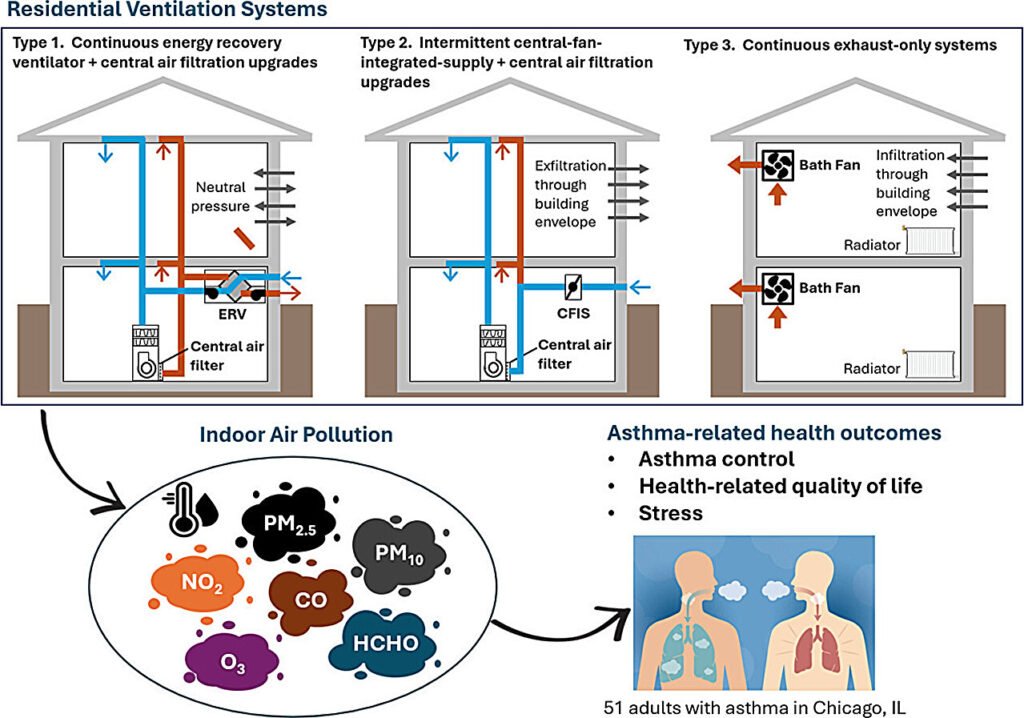For millions of people living with asthma, even the air inside their homes can make breathing difficult. But researchers at The University of Texas at Arlington have shown that better ventilation systems can make a measurable difference in helping people breathe more easily.
The study, coauthored by Insung Kang, assistant professor in UTA’s Department of Civil Engineering, found that improved residential ventilation systems can significantly enhance indoor air quality and reduce breathing difficulties for adults with asthma.
The study is published in the journal Building and Environment.
UTA collaborated with the Illinois Institute of Technology and Elevate, a nonprofit based in Chicago that works to ensure clean and affordable heat, cooling, power and water in homes. The three-year project, conducted in Chicago from 2017 to 2020, examined how different types of home ventilation systems affect indoor pollutants and respiratory health in adults with asthma.
“Recognizing how significantly indoor environments influence people’s health inspired me to dedicate my research to improving public health,” Dr. Kang said. “When we visited homes, we could see the difference these systems made, especially for families facing economic or environmental disparities.”
After a year of baseline monitoring, researchers installed one of three types of ventilation systems in participants’ homes: upgraded bathroom exhaust fans that run continuously to draw air in from the outside; a supply fan connected to the central heating and cooling system set that ran intermittently to push air into the home; or an energy recovery ventilator (ERV) that continuously exchanged indoor and outdoor air.
The supply and balanced systems circulated and filtered air, while the ERVs also conserved heating and cooling energy.
The findings showed that all three systems led to measurable improvements in indoor air quality and asthma outcomes during the study’s second year, when ventilation was activated. The ERV system produced the greatest improvements in asthma symptoms. Older adults—those over 45—experienced pronounced benefits.
“This work would not have been possible without funding … and the time and energy of our colleagues, contractors, and recruitment teams; donations from several manufacturers; and, of course, our study participants,” said principal investigator Brent Stephens of Illinois Tech.
“Each participant welcomed us into their homes for air quality monitoring, allowed contractors to install ventilation systems and completed dozens of surveys throughout the project.”
Anne Evens, Elevate CEO, said the research confirms that improved ventilation isn’t simply a building upgrade, but rather a public health solution.
“We’re honored to collaborate with The University of Texas at Arlington and Illinois Tech on this groundbreaking study,” Evens said. “Together, we’re demonstrating how evidence-based housing interventions can reduce health disparities and help families breathe easier.”
Kang completed the project as part of his doctoral research, an experience that shaped his career focus on environmental health and equitable technology design. Now leading the Built Environment and Health (BEH) research group at UTA, he continues to explore ways to make buildings healthier and more energy efficient across Texas and beyond.
He is currently conducting a similar study in urban homes across Dallas-Fort Worth.
More information:
Insung Kang et al, Effects of residential ventilation and filtration interventions on adult asthma outcomes, Building and Environment (2025). DOI: 10.1016/j.buildenv.2025.113577
Citation:
Research shows that improved home ventilation can ease asthma symptoms, advance public health (2025, October 31)
retrieved 31 October 2025
from https://medicalxpress.com/news/2025-10-home-ventilation-ease-asthma-symptoms.html
This document is subject to copyright. Apart from any fair dealing for the purpose of private study or research, no
part may be reproduced without the written permission. The content is provided for information purposes only.


